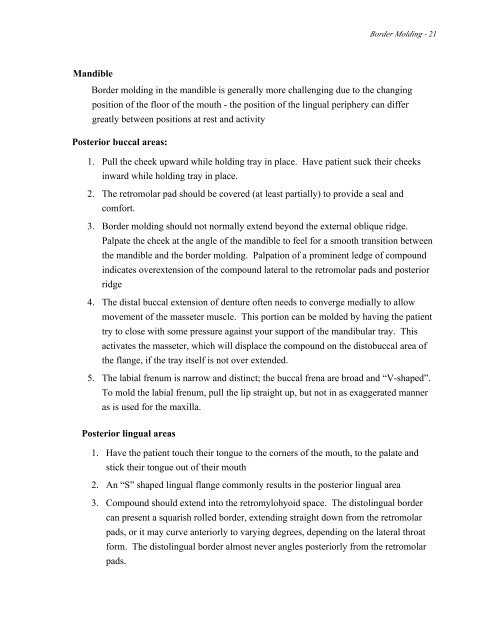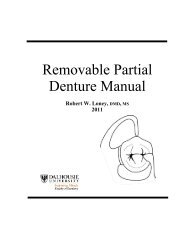Manuals_files/CD Manual 12.pdf - Removable Prosthodontics
Manuals_files/CD Manual 12.pdf - Removable Prosthodontics
Manuals_files/CD Manual 12.pdf - Removable Prosthodontics
Create successful ePaper yourself
Turn your PDF publications into a flip-book with our unique Google optimized e-Paper software.
Border Molding - 21<br />
Mandible<br />
Border molding in the mandible is generally more challenging due to the changing<br />
position of the floor of the mouth - the position of the lingual periphery can differ<br />
greatly between positions at rest and activity<br />
Posterior buccal areas:<br />
1. Pull the cheek upward while holding tray in place. Have patient suck their cheeks<br />
inward while holding tray in place.<br />
2. The retromolar pad should be covered (at least partially) to provide a seal and<br />
comfort.<br />
3. Border molding should not normally extend beyond the external oblique ridge.<br />
Palpate the cheek at the angle of the mandible to feel for a smooth transition between<br />
the mandible and the border molding. Palpation of a prominent ledge of compound<br />
indicates overextension of the compound lateral to the retromolar pads and posterior<br />
ridge<br />
4. The distal buccal extension of denture often needs to converge medially to allow<br />
movement of the masseter muscle. This portion can be molded by having the patient<br />
try to close with some pressure against your support of the mandibular tray. This<br />
activates the masseter, which will displace the compound on the distobuccal area of<br />
the flange, if the tray itself is not over extended.<br />
5. The labial frenum is narrow and distinct; the buccal frena are broad and “V-shaped”.<br />
To mold the labial frenum, pull the lip straight up, but not in as exaggerated manner<br />
as is used for the maxilla.<br />
Posterior lingual areas<br />
1. Have the patient touch their tongue to the corners of the mouth, to the palate and<br />
stick their tongue out of their mouth<br />
2. An “S” shaped lingual flange commonly results in the posterior lingual area<br />
3. Compound should extend into the retromylohyoid space. The distolingual border<br />
can present a squarish rolled border, extending straight down from the retromolar<br />
pads, or it may curve anteriorly to varying degrees, depending on the lateral throat<br />
form. The distolingual border almost never angles posteriorly from the retromolar<br />
pads.















